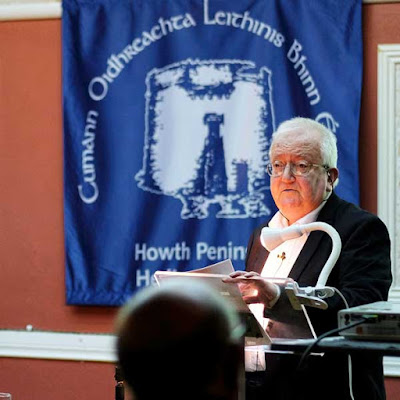If you needed to describe Fr. Brendan Fahey in a short phrase, this would be "a gentle soul".
He was a member of the Columban Order, a band of tough, dedicated missionary priests. I am particularly aware of their work in the Philippines. They have championed civil rights in dictatorships and defended the environment against capitalist onslaughts. And some have paid a high price.
I think Brendan's work was less turbulent in the parishes he ministered to in Japan. He became fluent in Japanese and fell in love with the culture there. He fully appreciated the contradiction in that culture which can involve the coexistence of extreme delicacy on the one hand and serious savagery on the other. This latter trait is, of course, not limited to the Japanese. We are all human at the end of the day.
Brendan was ordained in 1953 and spent most of his early ministry in Japan. I think he was heartbroken when he had to leave there. He had a varied career from then on but I have a feeling that some of his happiest times later in his ministry were when he was Parish Priest in the Welsh town of Denbigh.

Myself & Fr. Brendan at the Catholic Stand on the field
of the National Eisteddfod of Wales, in Denbigh, 2001
When we went to the National Eisteddfod there in 2001 he sorted out accommodation for us with one of the families in the parish and we had a lively dinner one evening in the parochial house.
This was a historic Eisteddfod where a woman won the Bardic Chair for the first time ever.
Brendan had the responsibility, and pleasure I think, of organising a Catholic stand on the Eisteddfod field. He told me afterwards that the bishop, who visited the stand, was most pleased.

Fr. Brendan celebrating the 60th anniversary of his ordination,
with sisters, Carmel (left) and Colette (right, 2013)
It was only recently that he celebrated the 60th anniversary of his ordination, which celebration he shared with a number of other priests and which was attended by his two living siblings.
Among the objects presented at the funeral mass were these, representing those areas of the world where Brendan had made a significant difference. I was very pleased to see Wales represented separately despite its being already implicitly included in the UK flag. Brendan would have appreciated the down-to-earthness of the Welsh object concerned.
It was great to meet Lynne again after all thes years but it was a bit overwhelming on such a sad occasion. Lynne and Brendan were wonderful best friends for the last seventeen years and the picture above is of happier times at Old Head. I had not seen Lynne since the Denbigh Eisteddfod in 2001.
While we're in the West, it is meet and just to mention Fr. Ned Crosby, Brendan's and my cousin. The picture was taken in Co. Clare, where they are breaking bara brith together. It was Ned's poem, Plough, that was read at both Brendan's 60th anniversary and at the funeral. The poem is reproduced in a comment below.
My cousins will never forgive me if I don't mention that Brendan was also a keen sportsman. He played for the Roscommon Minor Football Team in 1947 and he was also an excellent golfer.
He was also a keen gardener during his "retirement" in Dalgan Park. So much so that some of his colleagues imagine him with a bunch of sweet pea at the Pearly Gates to welcome their, hopefully not too imminent, arrival there.
You can read the biographical note from the funeral mass booklet here.
His brother, Ciaran, was also a priest. He ministered in the USA and died in 1995.
Brendan died at 11:45 pm on 24/1/2016 and was buried in the Order's cemetery in Dalgan Park on 27/1/2016.
This is how most of us will remember Brendan.
May he rest in peace.


















































